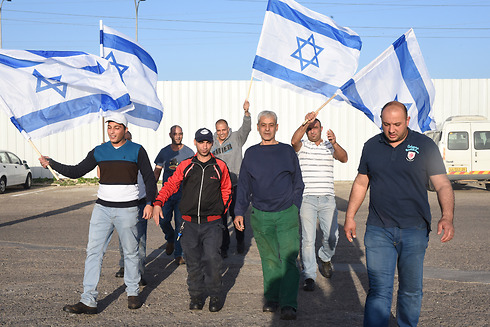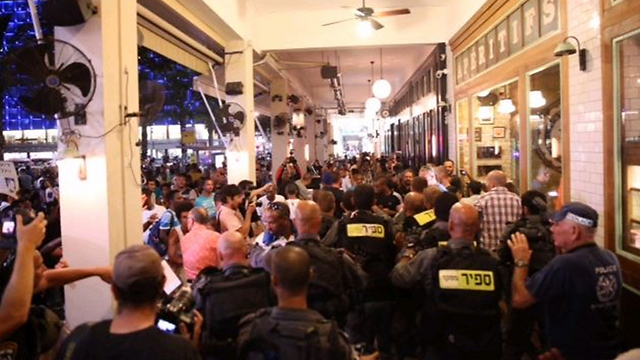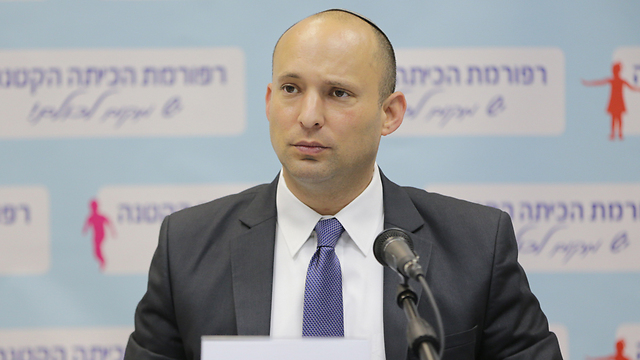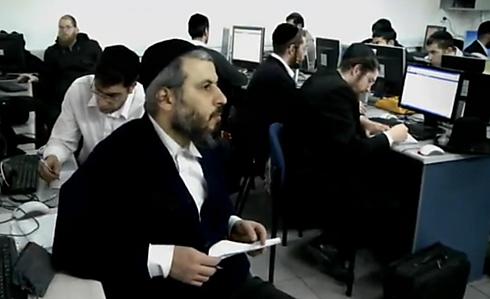
Our society is not disintegrating
Op-ed: There are indeed negative phenomena, such as racism and extremism, in Israel. But it's the media which give extremist voices outsize attention, concealing the fact that social gaps are actually decreasing.
It started before Operation Protective Edge, but since the end of the conflict, it’s been increasing. You can call it a "discourse of disintegration." A dialogue that imposes a grim atmosphere on us, one that to purports to be self-reflective, but in fact becomes self-flagellating. A dialogue whose main spokespeople claim that Israel’s society is turning into a more tribal, extremist, racist, and divided one.
No more melting pot. No more common grounds. No more “our nation,” “our land.” Israel’s president himself gave a huge boost to the discourse of disintegration when he gave his “tribe speech.” At the end of it he was applauded for his “courage to tell the truth.”
Truth? As far as media discussions are concerned, it is the truth. From “Ars Poetica” to the soccer hooligans of “La Familia” (the extremist fan club of Beitar Jerusalem supporters). From the extreme, sometimes anti-Semitic, left, to the terrorist Jewish jihad.
From Knesset members like Jamal Zhalka to internet commenters who encourage the murder of Arabs, the feeling is that of extremism and disintegration.
The social networks supply plenty of evidence to subscribers of the discourge of disintegration. It doesn’t stay there.
Newspapers and journalists are caught up in this conversation, and editorial pages, especially at a certain paper, sometimes resemble anti-Israel pashkvils (traditional posters, displayed in orthodox Jewish communities) – all in the guise of self-criticism and national reflection.
The rhetoric of disintegration succeeds because some of its proponents, radicals, are often educated, fascinating, and challenging.
A democratic society, which recognizes the importance of free speech, listens eagerly to these voices. But sometimes they aren’t challenging and enriching voices, but false and inciting ones.
One of the radical conversation’s spokespeople wrote in a poem that he burned the books of an Ashkenazi poet, and that was the signal for a groveling fest. He became authentic, original, remarkable.
A short time passed, and two things happened. First, he won an important poetry award. Second, he was respectfully invited to teach at Tel Aviv University.
Now let’s assume, just for a moment, that instead of Nathan Zach, the poet in question was Mahmoud Darwish. Would he have received a prize? Would he have been given a prize? Would he have been invited to teach? Would he have been considered “authentic”?
It seems that his entrance into certain progressive circles was given to him because he announced, what else, that he’s an anti-Zionist. I’ll take a guess and say: If that same poet had dared to proclaim himself a Zionist, he would have stayed deep in the margins.
The discourse of disintegration isn’t consistent, and includes disdain for extremism. But it has mainly been derailed to a different place: Hateful dialogue. Hatred toward the state of Israel, toward the Zionist project, toward the option of having a Jewish nation.
There are a few thousand, from the left and the right, Mizrahi and Ashkenazi, who participate in this hateful conversation. But they’re strong in certain media bodies. They don’t have an interest in societal solidarity. In fact, it’s the opposite. They spread the dismantling dialogue because dismantling is what they want.
The thing is, the discourse of disintegration is built on a lie – according to every objective measure, Israeli society is becoming more united and solidified – and even less extreme. The president spoke of four tribes painfully, not hatefully.
But the motive doesn’t make the speaker correct. The haredi people, for instance, have become much more assimilated in the last decade. There’s a rise in the percentage of haredi people who enlist in the IDF, and no less important – more haredi people are joining the workforce.
In 2010, just 40 percent of haredi men were employed. In 2013, it was over 55 percent. There’s also a marked rise in the percentage of haredi people who seek academic degrees.
Each negative haredi event, such as the attacks against women in Beit Shemesh, gets amplified attention. The haredi world has been going through a revolution in recent years. It is becoming more moderate, less extreme and exclusionist. But the impression you get is the other way around.
The second tribe on the spot is Israeli Arabs, or Palestinians with Israeli citizenship. According to popular opinion, they’re growing more and more apart from the Jewish-democratic Israel.
Is that so? The latest poll by the democratic institute says that 39 percent of Arabs are “proud to be Israeli”, and that 29 percent, heaven help us, are “very proud”. True, there are fluctuations due to tension-raising events. Such a poll, given during a time of conflict, would have different results from a peacetime poll.
However, these fluctuations can’t hide the fact that the Arab tribe, like the haredi tribe, is going through a process of Israelification. That doesn’t mean Arabs are Zionists now, but both Arabs and haredi people, the two groups allegedly out of the majority’s ethos – which is necessary for any society – are actually going through processes that are strengthening broader bonds.

The same goes for the Mizrahi tribe. Most of this tribe, by the way, doesn’t self-identify as such. But too few people, who are too radical, get too much of the attention. If aliens from another planet came to earth and read the work of certain writers, they’d get the impression that Mizrahi and Ashkenazi Jews are fist-fighting on Israeli streets. In reality, surprise surprise, the gaps are actually shrinking.
According to a study by Professor Momi Dahan, published last year, the gaps between Ashkenazi and Mizrahi Jews in average individual income has shrunk by 15 percent. That’s one percent every year. The big reason for this shrinking is private colleges. Unlike what was initially predicted, private colleges have mainly become a way for Mizrahi people to enter academia, and through it to higher-paying professions. That process is ongoing.
And what about the elites? Well, according to Dahan’s research the Mizrahi population’s part in the top 5 percent of income is in proportion with their size in the general population. You can add to this the fact that 70-80 percent of senior citizens in Israel have grandchildren who are of mixed Mizrahi-Ashkenazi descent.
That doesn’t mean we have cause for celebration yet. There are still gaps, there isn’t distributive justice, and there’s a need to take action. But at the end of the day, the already- eulogized melting pot is proving to be a simmering success, in the face of its critics.
The protests by Israelis of Ethiopian descent, which has been in the headlines this year, has created the impression that Ethiopian Jews have been left back. There’s no bigger falsehood. The percentage of Israeli-born Ethiopians who get their high school diploma is 53 percent. That is just a few percent below the number for the general population.

But what’s more important is the amazing rise in these numbers – those born in Ethiopia are still behind, but those born in Israel are catching up, almost entirely. This isn’t a story of failure, but of spectacular success.
But we only hear of violent police officers. Racist phenomena occur, but when you hear only about them and ignore the achievements and the shrinking of gaps, the result is basically a fraud.
Isolated violent incidents, two of them particularly loathsome – the burning of a teenage boy and the burning of a house, with a family sleeping inside it – have become another piece of evidence for a racist and violent society.
Is that so? Quiet and peaceful Netherlands, for instance, saw 117 cases of arson directed at mosques between 2005 and 2010. Much more than Israel. Even a single case of arson, just one, should be condemned. But 117 events didn’t turn Netherlands into a racist country. With us, a much smaller number of events leads to countless articles about a violent and racist society.
The nationalist-religious tribe has absorbed the majority of criticism regarding the rise of nationalistic extremism. But the attempt to connect the “price tag” (the name given to certain acts of vandalism aimed at Palestinians by Jewish nationalists) hooligans, or the ones responsible for the two aforementioned murders, to the wider religious public is tenuous.
There is a trend of national-religious Jews who are becoming more haredi, but there is also a wider phenomenon of liberal religious people. There are more and more orthodox synagogues that are broadening equality for women. A decade ago the leader of a national-religious political party wouldn’t have dared speak of equal rights for those with different sexual orientations. Today it’s happening. And even a loathsome murderer at the pride parade doesn’t change the underlying trend.
So why does it feel different? Why has the discourse of disintegration become a consensus, so powerful that the president of Israel was caught in its trap? Mostly because it’s a “discourse”, not a fact. Researcher George Gerbner found that there’s a big difference between what people think of the reality they live in and the actual facts. He called this gap the “mean world syndrome”. The more people are exposed to the media, explained Gerbner, the more they accept what they absorb. And the media, as is its nature, accentuates the negative. The results are predictable.
The world is also becoming better on a global level, unlike what impressions might indicate. According to World Bank statistics, in 1990 there were 1.91 billion people who lived on less than $1.25 a day. In 2011 it was just one billion. And the reduction in poverty contineus. The global jihad is ruining the show a little bit, by spreading destruction and oppression, and creating millions of refugees. But still, it affects tens of millions, not billions.
We live with a similar syndrome. The disintegration syndrome. The media doesn’t just report bad events, such as the murder in Duma, but also dedicates a much larger share of its time to radical voices, which become brokers of reality.
Sometimes these voices express discouragement. Sometimes they’re voices that take racist phenomena, that exist on the fringes, and apply them to an entire society. The social networks amplify this.

On the political level, there’s no objective proof that Israeli society is becoming more divided or extreme. On the contrary, the latest election results, as well as those before them, prove that parties with racist elements to them don’t get representation in the Knesset. People are abandoning the fringes for the mainstream. That’s the opposite of tribalism and extremism.
There are political disputes that are an expression of a vibrant democracy, but the collective ethos is much larger, and growing. And despite this, the disintegration syndrome manages to make the opposite seem true. It’s not that the disputes between different factions, different opinions, are becoming more severe. It’s just that the more extreme voices and fringe phenomena get an exaggerated amount of attention.
The absurd thing is that the disintegration syndrome has roots in freedom of speech. Whoever wrote a more radical poem or article is more likely to be invited to perform it on radio, television, or academia (on the condition of them being leftists, always leftists).
But the growing highlighting of extremist voices isn’t the true expression of free speech. Most religious right-wingers aren’t pro-Torat Hamelech (a book written by extremists, which says it’s permissible in some cases to kill non-Jews); most Mizrahi people aren’t for burning books, or even collective action based on ethnicity; and most leftists aren’t anti-Zionists.
But when the Mizrahi representatives are the Ars Poetica (a Mizrahi poetry event, considered quite radical by some) people, and the representatives of the left are Gideon Levy and Yair Garbuz, the result is the trampling of the majority in the name of free speech. The result is a skewed conversation. The result is the disintegration syndrome.
Israel has suffered from chronic diseases for decades. The first is the Israeli-Arab conflict. A state that has absorbed huge immigration waves and took in communities from dozens of places, and which experiences deep political conflicts.
Looking at all this, the facts are that political violence is nearly non-existent, the gaps between Mizrahi and Ashkenazi populations are shrinking, and increasing numbers of haredi and Arab people are coming closer to the mainstream.
You have to remember the violent election of 1981, the protests of the nineties, the murder of Prime Minister Yitzhak Rabin, and the fact that Ethiopian Jews started with nearly nothing – and look at where we are today. We should look at the direction we’re pointed in: Not more racism but less, not more violence but less.
Let’s not delude ourselves. There are conflicts, there are racist phenomena. But the direction is positive. Today’s Israel is a slightly more decent place than we might think. The discourse of disintegration is just a discourse. It creates a nationwide delusion, which we would do well to smash.
We’ve sinned and wronged. We shouldn’t hide that. And even with our sins, this Yom Kippur, we’re worthy of being inscribed in the book of life for good.











